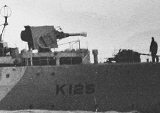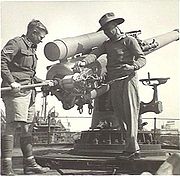
BL 4 inch Mk IX naval gun
Encyclopedia
The BL 4-inch gun Mk IX was a British medium-velocity naval gun introduced in 1916 as secondary armament on the Renown class battlecruiser
s and Glorious class
"large light cruisers", but which served most notably as the main armament on Flower class corvette
s throughout World War II
.

 The gun was based on the barrel of the QF 4 inch Mk V
The gun was based on the barrel of the QF 4 inch Mk V
and the breech mechanism of the BL 4 inch Mk VIII
and was first introduced in World War I on capital ship
s as secondary armament in triple-gun mountings, intended to provide rapid concentrated fire. This turned out to be unworkable in practice : Jane's Fighting Ships
of 1919 commented : "4-inch triples are clumsy and not liked. They are not mounted in one sleeve ; have separate breech mechanism : gun crew of 23 to each triple". Guns were thereafter used in single-gun mountings, typically on smaller ships as primary armament.
In World War II
the gun was employed on many small warships such as Flower class corvette
s and minesweepers, primarily for action against surfaced submarines.
This was the last BL 4 inch gun in British service: all subsequent guns have used charges in metal cartridges "QF". It was succeeded on new small warships built in World War II by the less powerfull QF 4-inch Mk XIX
gun.
Renown class battlecruiser
The Renown class consisted of a pair of battlecruisers built during the First World War for the Royal Navy. They were originally laid down as improved versions of the s. Their construction was suspended on the outbreak of war on the grounds they would not be ready in a timely manner...
s and Glorious class
Glorious class aircraft carrier
The Courageous class, sometimes called the Glorious class, was the first multi-ship class of aircraft carriers to serve with the Royal Navy. The three ships were originally laid down as "large light cruisers" to be used in the Baltic Project during the First World War...
"large light cruisers", but which served most notably as the main armament on Flower class corvette
Flower class corvette
The Flower-class corvette was a class of 267 corvettes used during World War II, specifically with the Allied navies as anti-submarine convoy escorts during the Battle of the Atlantic...
s throughout World War II
World War II
World War II, or the Second World War , was a global conflict lasting from 1939 to 1945, involving most of the world's nations—including all of the great powers—eventually forming two opposing military alliances: the Allies and the Axis...
.
History


QF 4 inch Mk V naval gun
The QF 4 inch Mk V gun was a Royal Navy gun of World War I which was adapted on HA mountings to the heavy anti-aircraft role both at sea and on land, and was also used as a coast defence gun.-Naval service:...
and the breech mechanism of the BL 4 inch Mk VIII
BL 4 inch naval gun Mk VIII
The BL 4-inch gun Mark VIII was a British medium-velocity wire-wound naval gun introduced in 1908 as an anti-torpedo boat gun in smaller ships whose decks could not support the strain of the heavier and more powerful Mk VII gun.-Mk VIII History:...
and was first introduced in World War I on capital ship
Capital ship
The capital ships of a navy are its most important warships; they generally possess the heaviest firepower and armor and are traditionally much larger than other naval vessels...
s as secondary armament in triple-gun mountings, intended to provide rapid concentrated fire. This turned out to be unworkable in practice : Jane's Fighting Ships
Jane's Fighting Ships
Jane's Fighting Ships is an annual reference book of information on all the world's warships arranged by nation, including information on ship's names, dimensions, armaments, silhouettes and photographs, etc...
of 1919 commented : "4-inch triples are clumsy and not liked. They are not mounted in one sleeve ; have separate breech mechanism : gun crew of 23 to each triple". Guns were thereafter used in single-gun mountings, typically on smaller ships as primary armament.
In World War II
World War II
World War II, or the Second World War , was a global conflict lasting from 1939 to 1945, involving most of the world's nations—including all of the great powers—eventually forming two opposing military alliances: the Allies and the Axis...
the gun was employed on many small warships such as Flower class corvette
Flower class corvette
The Flower-class corvette was a class of 267 corvettes used during World War II, specifically with the Allied navies as anti-submarine convoy escorts during the Battle of the Atlantic...
s and minesweepers, primarily for action against surfaced submarines.
This was the last BL 4 inch gun in British service: all subsequent guns have used charges in metal cartridges "QF". It was succeeded on new small warships built in World War II by the less powerfull QF 4-inch Mk XIX
QF 4 inch Mk XIX naval gun
The QF 4-inch Mk XIX gun was a British low-velocity 4-inch 40-calibre naval gun used to arm small warships such as Bathurst and Castle class corvettes and some River-class frigates in World War II, mainly against submarines...
gun.
Surviving examples
- On board HMCS Sackville (K181)HMCS Sackville (K181)HMCS Sackville was a Flower-class corvette that served in the Royal Canadian Navy and later served as a civilian research vessel. She is now a museum ship located in Halifax, Nova Scotia and the last surviving Flower-class corvette.-Wartime service:...
, the last surviving Flower class corvetteFlower class corvetteThe Flower-class corvette was a class of 267 corvettes used during World War II, specifically with the Allied navies as anti-submarine convoy escorts during the Battle of the Atlantic...
, at Halifax, Nova Scotia, Canada - A gun at the entrance to the marina in HullKingston upon HullKingston upon Hull , usually referred to as Hull, is a city and unitary authority area in the ceremonial county of the East Riding of Yorkshire, England. It stands on the River Hull at its junction with the Humber estuary, 25 miles inland from the North Sea. Hull has a resident population of...
, UK

